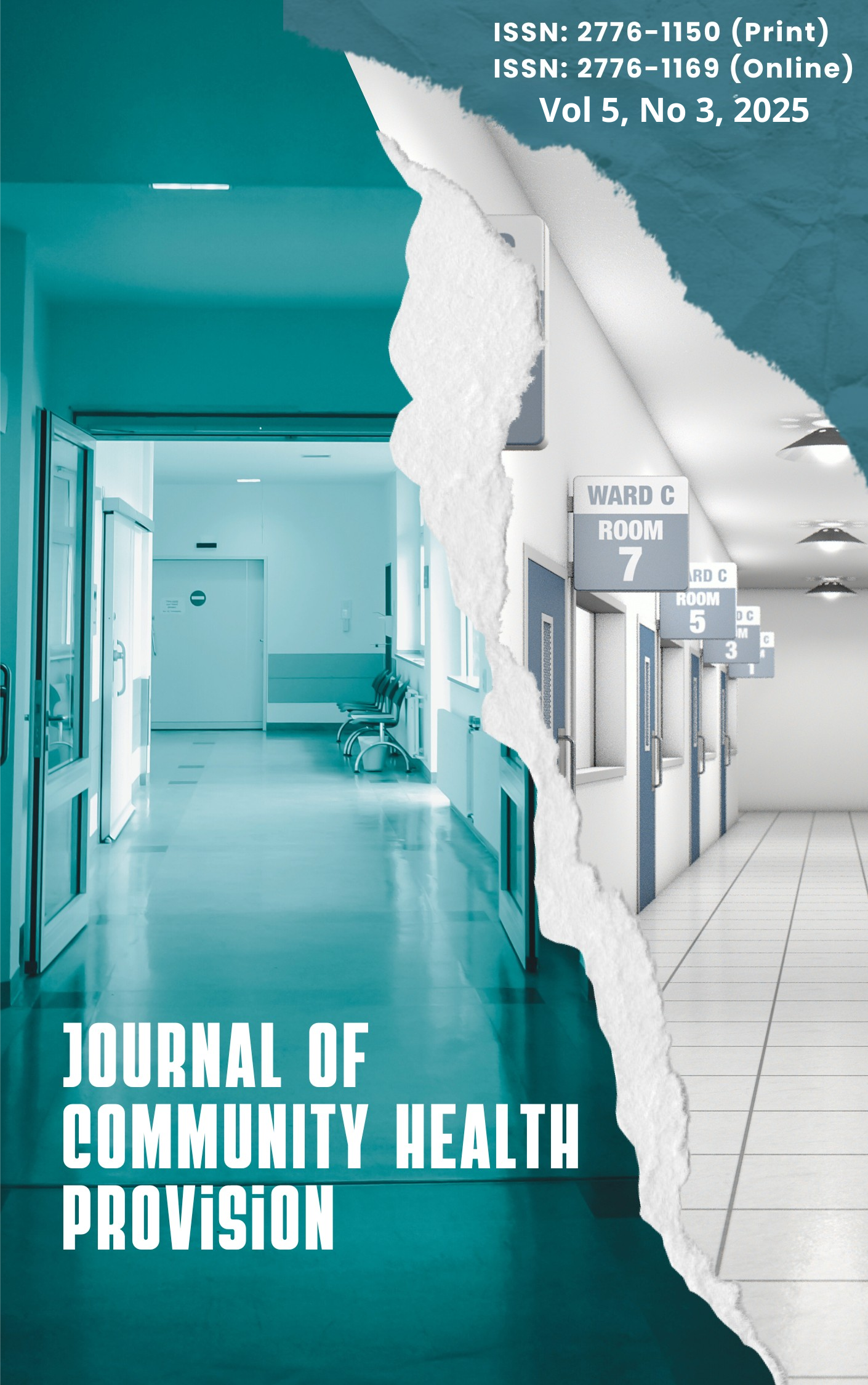Qualitative Study: The Role of Traditional Bejah and Poultice Practices in Uterine Recovery in Postpartum Mothers
Main Article Content
Abstract
Article Details

This work is licensed under a Creative Commons Attribution-ShareAlike 4.0 International License.
References
Bahar, B. (2020). Qualitative Study on Maternal Postpartum Health Care on Malayan People in Pontianak. International Journal of Multicultural and Multireligious Understanding. http://dx.doi.org/10.18415/ijmmu.v7i1.1258
Childs, C., Sandy-Hodgetts, K., Broad, C., Cooper, R., Manresa, M., & Verdú-Soriano, J. (2020). Birth-related wounds: risk, prevention and management of complications after vaginal and caesarean section birth. Journal of wound care, 29(Sup11a), S1-S48. https://doi.org/10.12968/jowc.2020.29.Sup11a.S1
Fadzil, F., Shamsuddin, K., & Wan Puteh, S. E. (2016). Traditional postpartum practices among Malaysian mothers: a review. The Journal of Alternative and Complementary Medicine, 22(7), 503-508. https://doi.org/10.1089/acm.2013.0469
Fahey, J. O., & Shenassa, E. (2013). Understanding and meeting the needs of women in the postpartum period: the perinatal maternal health promotion model. Journal of midwifery & women's health, 58(6), 613-621. https://doi.org/10.1111/jmwh.12139
Filippi, V., Chou, D., Barreix, M., Say, L., WHO Maternal Morbidity Working Group (MMWG), Barbour, K., ... & von Dadelszen, P. (2018). A new conceptual framework for maternal morbidity. International Journal of Gynecology & Obstetrics, 141, 4-9. https://doi.org/10.1002/ijgo.12463
Fithriani, A., Faridah, F., Syarqawi, F., & Jahra, P. M. (2024). Pamali and Multiculturalism: Islamic Thought in Preserving the Rights of Cultural Customs in Banjar Society. Kawanua International Journal of Multicultural Studies, 5(1), 125-138. https://doi.org/10.30984/kijms.v5i1.1087
Hall, H. G., McKenna, L. G., & Griffiths, D. L. (2012). Midwives’ support for complementary and alternative medicine: a literature review. Women and Birth, 25(1), 4-12. https://doi.org/10.1016/j.wombi.2010.12.005
Helgesson, G. (2015). Informants a potential threat to confidentiality in small studies. Medicine, Health Care and Philosophy, 18(1), 149-152. https://doi.org/10.1007/s11019-014-9579-4
Hishamshah, M., bin Ramzan, M. S., Rashid, A., Wan Mustaffa, W. N. H., Haroon, R., & Badaruddin, N. (2010). Belief and practices of traditional post partum care among a rural community in Penang Malaysia. The Internet Journal of Third World Medicine, 9(2), 1-9.
Karsnitz, D. B. (2013). Puerperal infections of the genital tract: a clinical review. Journal of midwifery & women's health, 58(6), 632-642. https://doi.org/10.1111/jmwh.12119
Lamxay, V., de Boer, H. J., & Björk, L. (2011). Traditions and plant use during pregnancy, childbirth and postpartum recovery by the Kry ethnic group in Lao PDR. Journal of Ethnobiology and Ethnomedicine, 7(1), 14. https://doi.org/10.1186/1746-4269-7-14
Lassi, Z. S., Mansoor, T., Salam, R. A., Das, J. K., & Bhutta, Z. A. (2014). Essential pre-pregnancy and pregnancy interventions for improved maternal, newborn and child health. Reproductive health, 11(Suppl 1), S2. https://doi.org/10.1186/1742-4755-11-S1-S2
Lesser, I. A., Turgeon, S., Nienhuis, C. P., & Bean, C. (2023). Examining the role of physical activity on psychological well-being and mental health postpartum. Women in Sport and Physical Activity Journal, 31(1), 40-49. https://doi.org/10.1123/wspaj.2022-0057
Molgora, S., & Accordini, M. (2020). Motherhood in the time of coronavirus: the impact of the pandemic emergency on expectant and postpartum women’s psychological well-being. Frontiers in Psychology, 11, 567155. https://doi.org/10.3389/fpsyg.2020.567155
Norhayati, M. N., Nik Hazlina, N. H., Asrenee, A. R., & Sulaiman, Z. (2017). The experiences of women with maternal near miss and their perception of quality of care in Kelantan, Malaysia: a qualitative study. BMC pregnancy and childbirth, 17(1), 189. https://doi.org/10.1186/s12884-017-1377-6
Renfrew, M. J., McFadden, A., Bastos, M. H., Campbell, J., Channon, A. A., Cheung, N. F., ... & Declercq, E. (2014). Midwifery and quality care: findings from a new evidence-informed framework for maternal and newborn care. The Lancet, 384(9948), 1129-1145.
Shewamene, Z., Dune, T., & Smith, C. A. (2020). Use of traditional and complementary medicine for maternal health and wellbeing by African migrant women in Australia: a mixed method study. BMC Complementary Medicine and Therapies, 20(1), 60. https://doi.org/10.1186/s12906-020-2852-6
Siyoto, S. (2019). Analysis of Uterus Involution, Lochea Expenditures and Back Pains on the Post Partum Mother Using Bengkung and Gurita. Indian Journal of Public Health Research & Development, 10(4). https://doi.org/10.5958/0976-5506.2019.00710.1
Swanborn, P. G. (1996). A common base for quality control criteria in quantitative and qualitative research. Quality and quantity, 30(1), 19-35. https://doi.org/10.1007/BF00139833
Sychareun, V., Somphet, V., Chaleunvong, K., Hansana, V., Phengsavanh, A., Xayavong, S., & Popenoe, R. (2016). Perceptions and understandings of pregnancy, antenatal care and postpartum care among rural Lao women and their families. BMC pregnancy and childbirth, 16(1), 245. https://doi.org/10.1186/s12884-016-1031-8
Trafimow, D. (2014). Considering quantitative and qualitative issues together. Qualitative Research in Psychology, 11(1), 15-24. https://doi.org/10.1080/14780887.2012.743202
Ward, Z. J., Atun, R., King, G., Sequeira Dmello, B., & Goldie, S. J. (2023). Simulation-based estimates and projections of global, regional and country-level maternal mortality by cause, 1990–2050. Nature medicine, 29(5), 1253-1261. https://doi.org/10.7910/DVN/UBGY9P
Webb, D. A., Bloch, J. R., Coyne, J. C., Chung, E. K., Bennett, I. M., & Culhane, J. F. (2008). Postpartum physical symptoms in new mothers: Their relationship to functional limitations and emotional well‐being. Birth, 35(3), 179-187. https://doi.org/10.1111/j.1523-536X.2008.00238.x
Yuniantini, U., & Nurvembrianti, I. (2022). The Effect of Malay Health Care on Postpartum Mothers in Pontianak. Journal of Asian Multicultural Research for Medical and Health Science Study, 3(3), 41-46. https://doi.org/10.47616/jamrmhss.v3i3.326

